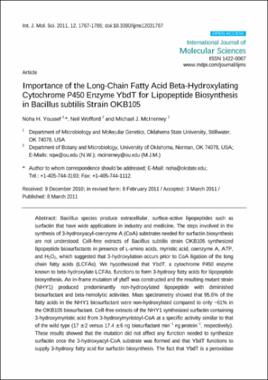| dc.contributor.author | Youssef, Noha H. | |
| dc.contributor.author | Wofford, Neil | |
| dc.contributor.author | McInerney, Michael J. | |
| dc.date.accessioned | 2019-09-25T18:24:45Z | |
| dc.date.available | 2019-09-25T18:24:45Z | |
| dc.date.issued | 2011-03-08 | |
| dc.identifier | oksd_youssef_importanceofthe_2011 | |
| dc.identifier.citation | Youssef, N. H., Wofford, N., & McInerney, M. J. (2011). Importance of the long-chain fatty acid beta-hydroxylating cytochrome P450 enzyme YbdT for lipopeptide biosynthesis in Bacillus subtilis strain OKB105. International Journal of Molecular Sciences, 12(3), 1767-1786. https://doi.org/10.3390/ijms12031767 | |
| dc.identifier.uri | https://hdl.handle.net/11244/321447 | |
| dc.description.abstract | Bacillus species produce extracellular, surface-active lipopeptides such as surfactin that have wide applications in industry and medicine. The steps involved in the synthesis of 3-hydroxyacyl-coenzyme A (CoA) substrates needed for surfactin biosynthesis are not understood. Cell-free extracts of Bacillus subtilis strain OKB105 synthesized lipopeptide biosurfactants in presence of L-amino acids, myristic acid, coenzyme A, ATP, and H2O2, which suggested that 3-hydroxylation occurs prior to CoA ligation of the long chain fatty acids (LCFAs). We hypothesized that YbdT, a cytochrome P450 enzyme known to beta-hydroxylate LCFAs, functions to form 3-hydroxy fatty acids for lipopeptide biosynthesis. An in-frame mutation of ybdT was constructed and the resulting mutant strain (NHY1) produced predominantly non-hydroxylated lipopeptide with diminished biosurfactant and beta-hemolytic activities. Mass spectrometry showed that 95.6% of the fatty acids in the NHY1 biosurfactant were non-hydroxylated compared to only ~61% in the OKB105 biosurfactant. Cell-free extracts of the NHY1 synthesized surfactin containing 3-hydroxymyristic acid from 3-hydroxymyristoyl-CoA at a specific activity similar to that of the wild type (17 ± 2 versus 17.4 ± 6 ng biosurfactant min−1·ng·protein−1, respectively). These results showed that the mutation did not affect any function needed to synthesize surfactin once the 3-hydroxyacyl-CoA substrate was formed and that YbdT functions to supply 3-hydroxy fatty acid for surfactin biosynthesis. The fact that YbdT is a peroxidase could explain why biosurfactant production is rarely observed in anaerobically grown Bacillus species. Manipulation of LCFA specificity of YbdT could provide a new route to produce biosurfactants with activities tailored to specific functions | |
| dc.format | application/pdf | |
| dc.language | en_US | |
| dc.publisher | MDPI | |
| dc.rights | This material has been previously published. In the Oklahoma State University Library's institutional repository this version is made available through the open access principles and the terms of agreement/consent between the author(s) and the publisher. The permission policy on the use, reproduction or distribution of the material falls under fair use for educational, scholarship, and research purposes. Contact Digital Resources and Discovery Services at lib-dls@okstate.edu or 405-744-9161 for further information. | |
| dc.title | Importance of the long-chain fatty acid beta-hydroxylating cytochrome P450 enzyme YbdT for lipopeptide biosynthesis in Bacillus subtilis strain OKB105 | |
| osu.filename | oksd_youssef_importanceofthe_2011.pdf | |
| dc.description.peerreview | Peer reviewed | |
| dc.identifier.doi | 10.3390/ijms12031767 | |
| dc.description.department | Microbiology and Molecular Genetics | |
| dc.type.genre | Article | |
| dc.type.material | Text | |
| dc.subject.keywords | bacillus subtilis | |
| dc.subject.keywords | ybdt | |
| dc.subject.keywords | beta hydroxylation | |
| dc.subject.keywords | cytochrome p450 | |
| dc.subject.keywords | long chain fatty acids | |
| dc.subject.keywords | surfactin | |
